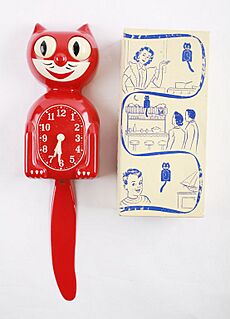Kit-Cat Klock facts for kids
The Kit-Cat Klock is a fun and decorative wall clock that looks like a happy, grinning cat. It has cartoon eyes that move from side to side, and its tail swings like a pendulum. This makes the clock seem alive!
Most Kit-Cat Klocks are black, but you can find them in many other colors and styles too. These clocks are a well-known symbol in kitchens across North America. They have a special design style called Art Deco, which was popular in the 1920s and 1930s.
Contents
The Story of the Kit-Cat Klock
The idea for the first Kit-Cat Klock came from Earl Arnault. Clifford Stone then created the first actual clock in 1932. His company, Allied Manufacturing Company, started making these clocks in Portland, Oregon.
Over the years, the company moved a few times. In the early 1940s, it moved to Seattle, Washington. Later, in 1962, it moved to southern California. At that time, the company changed its name to the California Clock Company. This is the company that still makes Kit-Cat Klocks today!
How the Clock Changed Over Time
The basic look of the Kit-Cat Klock has stayed mostly the same for many years. However, there have been a few small changes:
- The very first clocks, made from the 1930s to the early 1950s, had only two paws and no bow tie.
- Newer models of the clock have four paws and a bow tie.
- In the 1960s, some clocks even had real crystals added to them as decorations.
- The words "Kit-Cat" were added to the clock's face in 1982.
Originally, these clocks plugged into an electrical outlet. But in the late 1980s, they were changed to run on batteries. This made them easier to use anywhere. The company believes that for the last 50 years, about one Kit-Cat Klock has been sold every three minutes!
Kit-Cat Klocks in Pop Culture
You might have seen Kit-Cat Klocks in many places! They often appear in movies, TV shows, commercials, and advertisements. Their unique look makes them easy to spot.
The California Clock Company has also made other fun, animated clocks. These include clocks shaped like a teddy bear, a panda, a poodle, and even an owl. The name "Kit-Cat" is a special trademark of the California Clock Company.
See also
- Black cat



